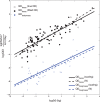Lateral diffusion of nutrients by mammalian herbivores in terrestrial ecosystems
- PMID: 23951141
- PMCID: PMC3739793
- DOI: 10.1371/journal.pone.0071352
Lateral diffusion of nutrients by mammalian herbivores in terrestrial ecosystems
Abstract
Animals translocate nutrients by consuming nutrients at one point and excreting them or dying at another location. Such lateral fluxes may be an important mechanism of nutrient supply in many ecosystems, but lack quantification and a systematic theoretical framework for their evaluation. This paper presents a mathematical framework for quantifying such fluxes in the context of mammalian herbivores. We develop an expression for lateral diffusion of a nutrient, where the diffusivity is a biologically determined parameter depending on the characteristics of mammals occupying the domain, including size-dependent phenomena such as day range, metabolic demand, food passage time, and population size. Three findings stand out: (a) Scaling law-derived estimates of diffusion parameters are comparable to estimates calculated from estimates of each coefficient gathered from primary literature. (b) The diffusion term due to transport of nutrients in dung is orders of magnitude large than the coefficient representing nutrients in bodymass. (c) The scaling coefficients show that large herbivores make a disproportionate contribution to lateral nutrient transfer. We apply the diffusion equation to a case study of Kruger National Park to estimate the conditions under which mammal-driven nutrient transport is comparable in magnitude to other (abiotic) nutrient fluxes (inputs and losses). Finally, a global analysis of mammalian herbivore transport is presented, using a comprehensive database of contemporary animal distributions. We show that continents vary greatly in terms of the importance of animal-driven nutrient fluxes, and also that perturbations to nutrient cycles are potentially quite large if threatened large herbivores are driven to extinction.
Conflict of interest statement
Figures






References
-
- Vitousek PM (2004) Nutrient cycling and limitation : Hawai’i as a model system. Princeton: Princeton University Press. 223 p.
-
- Hedin LO, Armesto JJ, Johnson AH (1995) Patterns of Nutrient Loss from Unpolluted, Old-Growth Temperate Forests - Evaluation of Biogeochemical Theory. Ecology 76: 493–509.
-
- Porder S, Vitousek PM, Chadwick OA, Chamberlain CP, Hilley GE (2007) Uplift, erosion, and phosphorus limitation in terrestrial ecosystems. Ecosystems 10: 158–170.
-
- Buendia C, Kleidon A, Porporato A (2010) The role of tectonic uplift, climate, and vegetation in the long-term terrestrial phosphorous cycle. Biogeosciences 7: 2025–2038.
-
- Okubo A, Levin SA (2001) Diffusion and ecological problems : modern perspectives 2nd Ed. New York: Springer. 467 p.
Publication types
MeSH terms
LinkOut - more resources
Full Text Sources
Other Literature Sources

